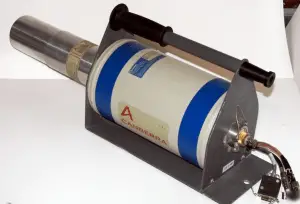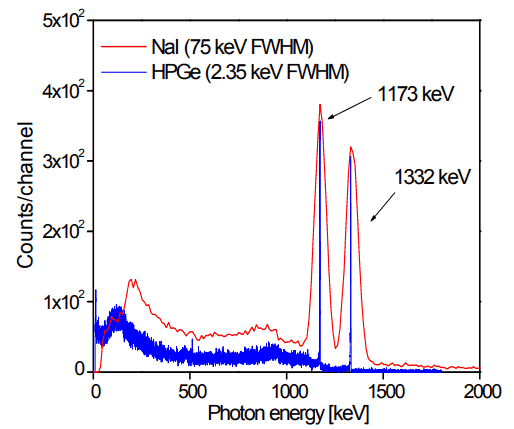
High-purity germanium detectors (HPGe detectors) are the best solution for precise gamma and x-ray spectroscopy. Compared to silicon detectors, germanium is much more efficient than silicon for radiation detection due to its atomic number being much higher than silicon and lower average energy necessary to create an electron-hole pair, which is 3.6 eV for silicon and 2.9 eV for germanium. Due to its higher atomic number, Ge has a much larger linear attenuation coefficient, which leads to a shorter mean free path. Moreover, silicon detectors cannot be thicker than a few millimeters. At the same time, germanium can have a depleted, sensitive thickness of centimeters. It, therefore, can be used as a total absorption detector for gamma rays up to a few MeV.
Since HPGe detectors produce the highest resolution commonly available today, they are used to measure radiation in a variety of applications, including personnel and environmental monitoring for radioactive contamination, medical applications, radiometric assay, nuclear security, and nuclear plant safety.
Application of HPGe Detectors – Gamma Spectroscopy
As was written, the study and analysis of gamma-ray spectra for scientific and technical use are called gamma spectroscopy. Gamma-ray spectrometers are the instruments that observe and collect such data. A gamma-ray spectrometer (GRS) is a sophisticated device for measuring the energy distribution of gamma radiation. For the measurement of gamma rays above several hundred keV, there are two detector categories of major importance, inorganic scintillators such as NaI(Tl) and semiconductor detectors. In the previous articles, we described gamma spectroscopy using a scintillation detector, which consists of a suitable scintillator crystal, a photomultiplier tube, and a circuit for measuring the height of the pulses produced by the photomultiplier. The advantages of a scintillation counter are its efficiency (large size and high density) and the possible high precision and counting rates. Due to the high atomic number of iodine, a large number of all interactions will result in complete absorption of gamma-ray energy so that the photo fraction will be high.

But if a perfect energy resolution is required, we must use a germanium-based detector, such as the HPGe detector. Germanium-based semiconductor detectors are most commonly used where a very good energy resolution is required, especially for gamma and x-ray spectroscopy. In gamma spectroscopy, germanium is preferred due to its atomic number being much higher than silicon, increasing the probability of gamma-ray interaction. Moreover, germanium has lower average energy necessary to create an electron-hole pair, which is 3.6 eV for silicon and 2.9 eV for germanium. This also provides the latter with a better resolution in energy. The FWHM (full width at half maximum) for germanium detectors is an energy function. For a 1.3 MeV photon, the FWHM is 2.1 keV, which is very low.